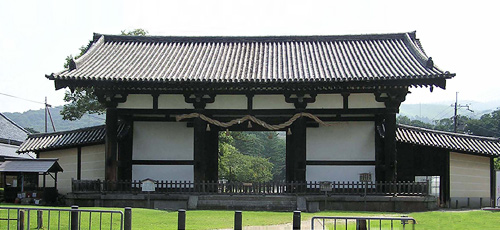|
||
 |
||

Toudaiji
Tegaimon 東大寺転害門 (Nara)
(C)2001 Japanese Architecture and Art Net Users System. No reproduction or republication without written permission.
掲載のテキスト・写真・イラストなど、全てのコンテンツの無断複製・転載を禁じます。
|
||||||
| hakkyakumon 八脚門 | ||||||
| KEY WORD : architecture / gates | ||||||
| Also read yatsuashimon. Also called sangen
ikkomon 三間一戸門 or sangen sankomon 三間三戸門 depending upon the number of
entrances in a three-bay wide gate. Lit. an eight-legged gate. Eight secondary
pillars are placed on the same axis at front and back of the gate. They support
four main pillars positioned in the center of the gate beneath the ridge *munagi
棟木. Hence, it is really a gate composed of twelve pillars. All the pillars
are round and of the same diameter. This arrangement results in a 3x2 bay gate.
Usually, only the center bay provides a walk-through space but some of the three-bay
gates have an entrance in each bay. The greater percentage have gabled roofs
*kirizuma yane 切妻屋根,
but occasionally they have hip-and-gabled roofs *irimoya
yane 入母屋根. This style of gate dates as far back as the Nara period.
Examples include: Motoyamadera Nioumon 本山寺二王門 (1485) in Kagawa prefecture.
It is an eight-legged gate with a gabled roof covered with tile *hongawarabuki
本瓦葺; Kibitsu Jinja Minamizuijinmon 吉備津神社南随身門 (1357) in Okayama prefecture. See *zuijinmon 随身門. It
is an eight-legged gate with a tiled hip-and-gable roof. Four-legged gates may
also have undulating gables either on the gable ends, yotsuashi hirakaramon
四脚平唐門, or on the front and back bargeboards, yotsuashi mukaikaramon 四脚向唐門.
|
||||||
 Toudaiji
Tegaimon 東大寺転害門 (Nara)
|
||||||
| REFERENCES: | ||||||
| *shikyakumon 四脚門 | ||||||
| EXTERNAL LINKS: | ||||||
| NOTES: | ||||||
(C)2001 Japanese Architecture and Art Net Users System. No reproduction or republication without written permission. 掲載のテキスト・写真・イラストなど、全てのコンテンツの無断複製・転載を禁じます。 |
||||||